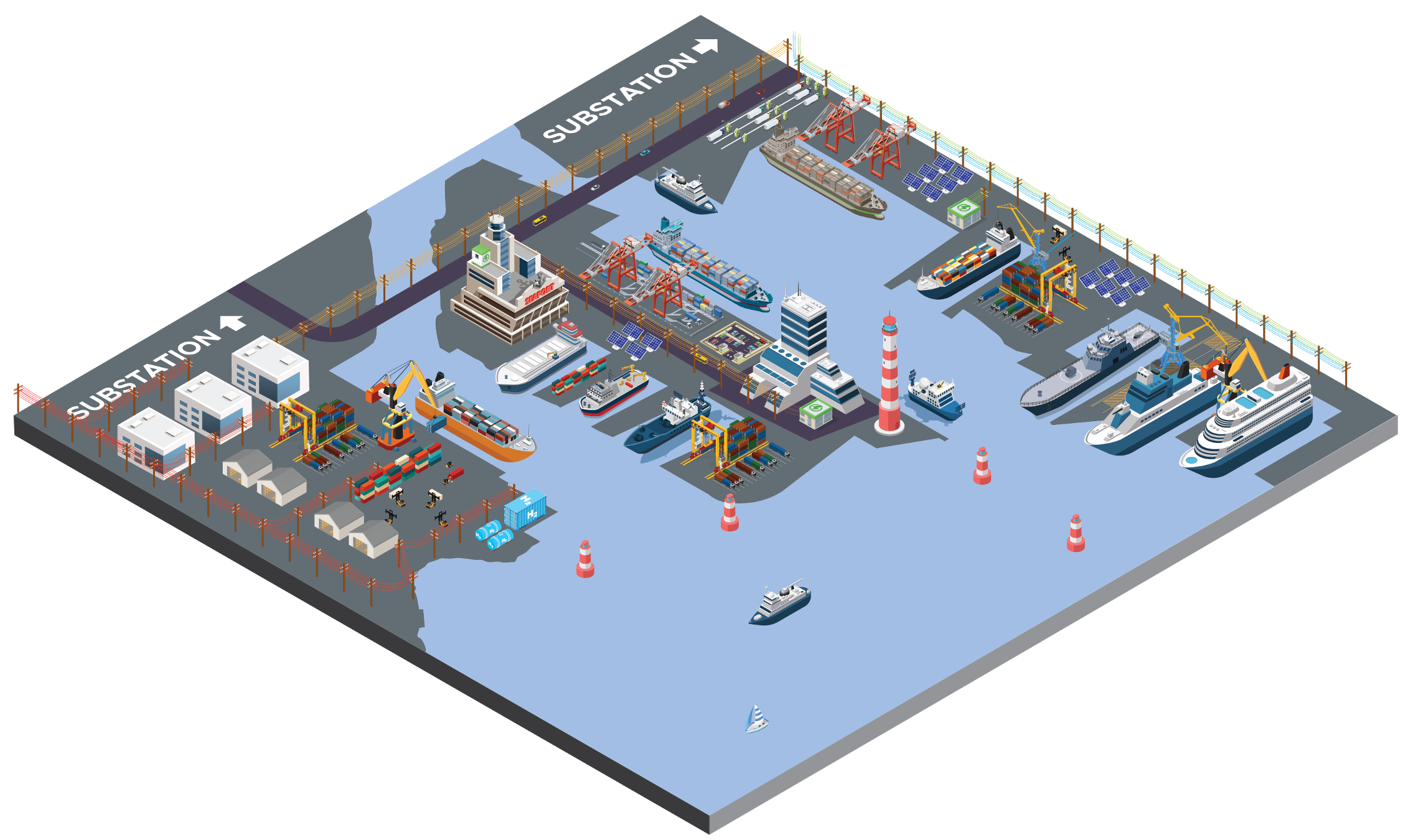Innovation Areas
The Pacific Northwest National Laboratory (PNNL) conducts cutting-edge research in several key areas, focusing on advancing technologies and solutions to drive the future of port operations. PNNL’s primary research areas include the following:
Energy Resilience
Ports must withstand and quickly recover from energy disruptions. PNNL develops strategies and technologies to enhance the resilience of port infrastructure, enabling smooth operation, even in adverse conditions. PNNL has supported individual ports in identifying vulnerabilities to critical infrastructure and has also broadly evaluated resiliency vulnerabilities related to port operations nationwide.
Microgrids

According to the Department of Energy, a microgrid is “a group of interconnected loads and distributed energy resources within clearly defined electrical boundaries that act as a single controllable entity with respect to the grid (source).” Microgrids can operate when connected to the grid and also while in island-mode, ensuring that critical port operations remain functional during unexpected power outages. PNNL has developed microgrid designs for multiple ports, evaluating various technologies to meet specific operational demands and goals. Microgrid technology can support the continuous operation of essential infrastructure, such as fuel supply systems, lighting, electric vehicles, and cargo handling equipment, while also offering economic benefits like demand charge reduction and (in some cases) the ability to sell excess electricity back to the grid.
On-Site Energy Generation
Ports are experiencing a growing power demand to support new electric loads and services, leading to a multifold increase in electricity demand. Traditional infrastructure may struggle to meet this rising load due to availability and timing constraints. On-site or near-site energy generation provides an opportunity for ports to diversify their energy portfolio by integrating new energy resources, such as solar photovoltaic systems or energy storage. Marine energy, currently in pilot phases, also holds potential for marine ports. PNNL collaborates with ports to assess opportunities for on-site and near-site energy generation, associated costs, and integration strategies to create a more diverse and cost-effective port energy ecosystem.
Ports as Regional Energy Resources
Strategic planning and regional coordination are essential for ports transitioning their energy systems. Without these efforts, energy transition activities could exacerbate grid constraints and result in fragmented investments. However, with advanced planning, port energy activities can be leveraged to develop resilient energy infrastructure that benefits local economies, communities, and national security. PNNL supports ports in their efforts to become integral assets to the regional energy landscape through its leading research in grid modernization, energy systems analysis, and port energy innovation.
Energy Diversification
Energy diversification enables ports to remain competitive, comply with evolving regulations, and adapt to unforeseen circumstances. By incorporating redundancy and flexibility, it reduces reliance on a single fuel source, mitigating impacts of potential market constraints and geopolitical influences. For ports, energy diversification involves exploring a range of innovative energy sources that are tailored to factors, such as resource availability, geographic location, operational structure, and market dynamics.
Electrification
While ports have historically used electricity for certain standard operations, there is a growing trend to transition more port activities to electric power. This shift significantly impacts the port's electrical load and infrastructure requirements. Port electrification encompasses a variety of projects and programs, including the adoption of electric-powered vessels, trucks, and cargo handling equipment. PNNL is researching and implementing technologies to expand the pool of energy resources available to ports, support electric loads, and integrate management solutions like managed charging and microgrids. Thoughtful planning and implementation of these solutions can make ports more resilient, energy-efficient, and economically viable.
Hydrogen

PNNL is at the forefront of hydrogen research, exploring innovative ways to utilize hydrogen as an alternative energy carrier in port and maritime operations. PNNL's research aims to advance hydrogen production, storage, and utilization technologies that can be seamlessly integrated into port infrastructure, enhancing both energy efficiency and environmental performance. PNNL has helped ports and utilities assess how hydrogen and hydrogen-based fuels could help ports meet their energy goals. PNNL is also a founding member of the Hydrogen Safety Panel where it provides technical support and advice on matters related to hydrogen safety review and project implementation.
Biofuels
Biofuels present a significant opportunity as a drop-in replacement for traditional fuels, making them a desirable candidate for near-term fuel alternatives. The availability, costs, and benefits of biofuels depend on sufficient feedstocks and energy for production. PNNL is actively exploring how biomass-derived fuels can be implemented in the maritime sector. Recent research has particularly focused on ocean-going vessels, which face increasing demands to transition away from traditional fuels due to international policies and customer preferences.
Other Marine Fuels
A variety of alternative fuels for ocean-going vessels are gaining international traction, helping them meet increasingly stringent emissions requirements. Each fuel presents unique characteristics that require careful planning for ports, bunkering operations, and vessel owners/operators. Leading alternative marine fuels include liquid natural gas, methanol, and ammonia—each offering distinct benefits and challenges within the maritime sector. To facilitate planning, PNNL partnered with the International Associations of Ports and Harbors to create a Port Readiness Level Tool for Marine Fuels.